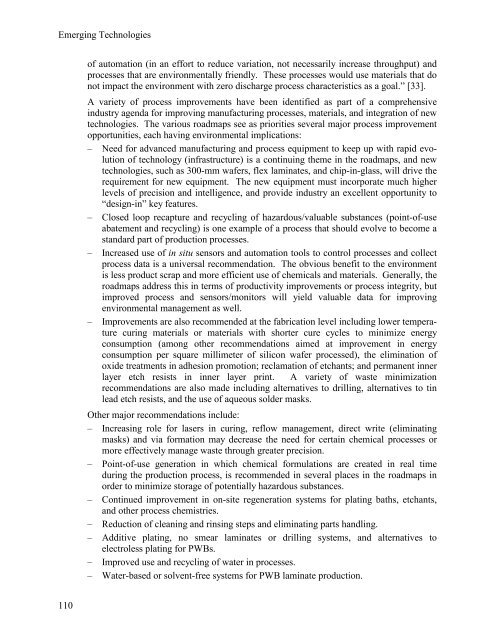1996 Electronics Industry Environmental Roadmap - Civil and ...
1996 Electronics Industry Environmental Roadmap - Civil and ...
1996 Electronics Industry Environmental Roadmap - Civil and ...
You also want an ePaper? Increase the reach of your titles
YUMPU automatically turns print PDFs into web optimized ePapers that Google loves.
Emerging Technologies<br />
110<br />
of automation (in an effort to reduce variation, not necessarily increase throughput) <strong>and</strong><br />
processes that are environmentally friendly. These processes would use materials that do<br />
not impact the environment with zero discharge process characteristics as a goal.” [33].<br />
A variety of process improvements have been identified as part of a comprehensive<br />
industry agenda for improving manufacturing processes, materials, <strong>and</strong> integration of new<br />
technologies. The various roadmaps see as priorities several major process improvement<br />
opportunities, each having environmental implications:<br />
– Need for advanced manufacturing <strong>and</strong> process equipment to keep up with rapid evolution<br />
of technology (infrastructure) is a continuing theme in the roadmaps, <strong>and</strong> new<br />
technologies, such as 300-mm wafers, flex laminates, <strong>and</strong> chip-in-glass, will drive the<br />
requirement for new equipment. The new equipment must incorporate much higher<br />
levels of precision <strong>and</strong> intelligence, <strong>and</strong> provide industry an excellent opportunity to<br />
“design-in” key features.<br />
– Closed loop recapture <strong>and</strong> recycling of hazardous/valuable substances (point-of-use<br />
abatement <strong>and</strong> recycling) is one example of a process that should evolve to become a<br />
st<strong>and</strong>ard part of production processes.<br />
– Increased use of in situ sensors <strong>and</strong> automation tools to control processes <strong>and</strong> collect<br />
process data is a universal recommendation. The obvious benefit to the environment<br />
is less product scrap <strong>and</strong> more efficient use of chemicals <strong>and</strong> materials. Generally, the<br />
roadmaps address this in terms of productivity improvements or process integrity, but<br />
improved process <strong>and</strong> sensors/monitors will yield valuable data for improving<br />
environmental management as well.<br />
– Improvements are also recommended at the fabrication level including lower temperature<br />
curing materials or materials with shorter cure cycles to minimize energy<br />
consumption (among other recommendations aimed at improvement in energy<br />
consumption per square millimeter of silicon wafer processed), the elimination of<br />
oxide treatments in adhesion promotion; reclamation of etchants; <strong>and</strong> permanent inner<br />
layer etch resists in inner layer print. A variety of waste minimization<br />
recommendations are also made including alternatives to drilling, alternatives to tin<br />
lead etch resists, <strong>and</strong> the use of aqueous solder masks.<br />
Other major recommendations include:<br />
– Increasing role for lasers in curing, reflow management, direct write (eliminating<br />
masks) <strong>and</strong> via formation may decrease the need for certain chemical processes or<br />
more effectively manage waste through greater precision.<br />
– Point-of-use generation in which chemical formulations are created in real time<br />
during the production process, is recommended in several places in the roadmaps in<br />
order to minimize storage of potentially hazardous substances.<br />
– Continued improvement in on-site regeneration systems for plating baths, etchants,<br />
<strong>and</strong> other process chemistries.<br />
– Reduction of cleaning <strong>and</strong> rinsing steps <strong>and</strong> eliminating parts h<strong>and</strong>ling.<br />
– Additive plating, no smear laminates or drilling systems, <strong>and</strong> alternatives to<br />
electroless plating for PWBs.<br />
– Improved use <strong>and</strong> recycling of water in processes.<br />
– Water-based or solvent-free systems for PWB laminate production.






